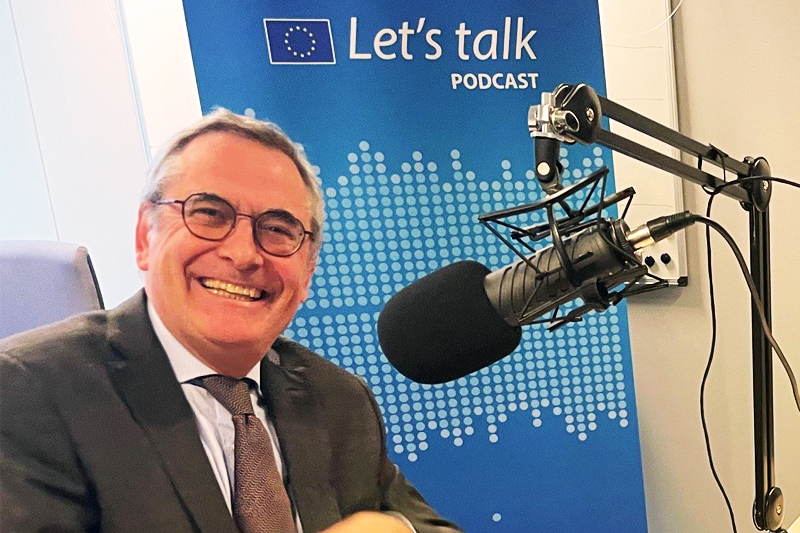Dominique Laboureix

Related topics
Bankingdate: 21/12/2023
Dominique Laboureix is Chair of the Single Resolution Board (SRB), as well as one of its founding Board Members. He talks about his first year in the job, how bank resolution works and its role within the Banking Union, and how he thinks the SRB could cooperate even more effectively with national resolution authorities.
You've been the Chair of the SRB for just about a year. How's it going so far?
Well, on a personal level, I’d say I'm as enthusiastic as during the first days. It's a challenging job because I need to build the Single Resolution Mechanism, not only managing the SRB but also all the relationships with the National Resolution Authorities, the third-country authorities, etc. So that means it's a permanently challenging environment with new risks. We've seen, for instance, the extremely fast-moving crises coming from the U.S. and Switzerland, and they have stopped at the borders of the Banking Union. What is key is to be prepared, beyond taking resolution decisions when necessary. We need to be up and running all the time.
And what did you do before the SRB?
I came from the French Central Bank – so I am a central banker. And just before joining the SRB as Chair, I was Secretary General of the French Prudential Authority in charge of supervising banks and insurance undertakings. So, basically my profile is a long-term one as a central banker, supervisor of banks, and also a little bit insurance undertakings.
What are your projects for the SRB going forward?
I have launched a strategic review. We started the SRB from scratch – there was nothing before 2015, so we started from zero. Now we have more or less 450 staff members. So, we've become something significant, and it was the right moment to launch a new strategy. And this is exactly what we have worked on – with the staff members themselves, with the national resolution authorities, and we’ve also consulted the industry. We are finalising the adoption of this strategy, which is planned for January next year and which will launch the new elements for the five coming years. The new elements are essentially shifting from building the resolution plan strategy to being able to implement it in real life. So, much more operational compared to the first few years.
The Single Resolution Mechanism, which is made up of the SRB and the National resolution authorities, is what we call the ‘second pillar’ of the EU's Banking Union. Could you explain what Banking Union is?
The Banking Union was born out of the great financial crisis of 2008. At that moment, the European bodies looked at the situation and concluded that lack of centralisation of supervision and perhaps also a lack of regulation were among the reasons for the banks’ failure. So, the EU regulators at that time – that's to say in 2014 and 2015 – decided to completely revisit the framework for regulating banks, with increased requirements in terms of solvency ratios, liquidity ratios, etc. They also decided to implement another way of supervising banks. They created the single supervisory mechanism (SSM), centralising at the European Central Bank (ECB) the powers for supervising big banks, and creating an oversight function for less-significant institutions. In parallel, they created a system for resolving banks. So again, a regulatory framework applicable to all EU members, plus a dedicated organisation for implementing this resolution framework. And this is the second pillar of the Banking Union – the single resolution mechanism, which has at its centre the SRB, and a periphery made of the national resolution authorities from the 21 members of the Banking Union.
What exactly is bank resolution?
Bank resolution is something completely new in Europe. In the United States, on the other hand, it’s been around for a very long time. The resolution authority was created in the United States almost one century ago, in 1933. The first objective is to organise an orderly disappearance of failing banks instead of letting them go through the normal process for any corporate which is failing. For a bank, a normal insolvency procedure and/or a liquidation process is extremely detrimental to financial stability. The consequences are very concrete on you and me – we cannot access ATMs anymore, we cannot go to our branch to discuss our loan or our mortgage, we cannot close our account, but need to wait for the liquidation process… So, it was decided to create a sort of parallel system for some banks for which there's an interest in preserving financial stability.
The second goal is directly linked to the great financial crisis. Because, in its aftermath, the reality is that the banking system was saved with public money – your money, my money. So, the Europeans decided that this should not happen anymore. In building the resolution system, the idea is to ask the bank – its shareholders and other creditors – to build sufficient buffers to be able to pay for its failure itself, instead of using public money.
How do you think the SRB could cooperate even more effectively with national resolution authorities?
That's definitely a crucial question. Because, in our extremely technical work, one thing is certain: even if we make the decisions in Brussels, implementation happens locally – through the national resolution authority – because we are speaking about local banks. From that perspective, the quality and the depth of the relationships with the national resolution authorities is absolutely key. That's why, within our strategic revision we are working on reinforcing these relationships. For instance, we want a greater participation of the National Resolution Authorities in building our internal policies and developing our different tools. We want to develop a much deeper and more common culture, through the organisation of common events, for instance, where both sides participate. We also want to reinforce cooperation when it comes to staff exchanges – receiving staff from the National Resolution Authorities and sending people from the SRB to these national authorities. This is a perfect example of building something better together.
There will be a longer version of this interview in the @EU_Finance podcast early next year.

Dominique Laboureix
